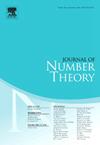自共轭分区和奇部明显分区的钩长偏差
IF 0.6
3区 数学
Q3 MATHEMATICS
引用次数: 0
摘要
我们建立了自共轭分区和不同奇部分区之间的钩子长度偏差,证明了对于足够大的n, n的自共轭分区中固定长度t≥2的钩子比n的不同奇部分区中固定长度t的钩子更多。更准确地说,我们导出了两类中固定长度t的钩子总数的渐近公式。这就解决了百龄坛、博雅、克雷格、福尔松和文的猜想。本文章由计算机程序翻译,如有差异,请以英文原文为准。
Hook length biases for self-conjugate partitions and partitions with distinct odd parts
We establish a hook length bias between self-conjugate partitions and partitions of distinct odd parts, demonstrating that there are more hooks of fixed length among self-conjugate partitions of n than among partitions of distinct odd parts of n for sufficiently large n. More precisely, we derive asymptotic formulas for the total number of hooks of fixed length t in both classes. This resolves a conjecture of Ballantine, Burson, Craig, Folsom, and Wen.
求助全文
通过发布文献求助,成功后即可免费获取论文全文。
去求助
来源期刊

Journal of Number Theory
数学-数学
CiteScore
1.30
自引率
14.30%
发文量
122
审稿时长
16 weeks
期刊介绍:
The Journal of Number Theory (JNT) features selected research articles that represent the broad spectrum of interest in contemporary number theory and allied areas. A valuable resource for mathematicians, the journal provides an international forum for the publication of original research in this field.
The Journal of Number Theory is encouraging submissions of quality, long articles where most or all of the technical details are included. The journal now considers and welcomes also papers in Computational Number Theory.
Starting in May 2019, JNT will have a new format with 3 sections:
JNT Prime targets (possibly very long with complete proofs) high impact papers. Articles published in this section will be granted 1 year promotional open access.
JNT General Section is for shorter papers. We particularly encourage submission from junior researchers. Every attempt will be made to expedite the review process for such submissions.
Computational JNT . This section aims to provide a forum to disseminate contributions which make significant use of computer calculations to derive novel number theoretic results. There will be an online repository where supplementary codes and data can be stored.
 求助内容:
求助内容: 应助结果提醒方式:
应助结果提醒方式:


